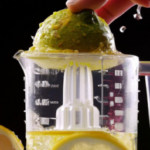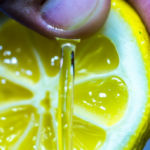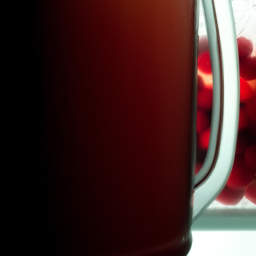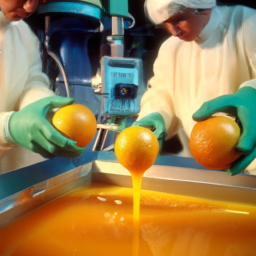As a seafood lover, I enjoy experimenting with various fish dishes. However, the lingering odor in the kitchen and on my hands post fish preparation can be off-putting. Thankfully, I have found a simple solution to get rid of this fishy smell: lemon juice.
But how does this citrus fruit effectively eliminate the pungent scent of fish? In this article, I will delve into the science behind fish odor, the chemical composition of lemon juice, and how it works to remove fish odor. I will also share some tips for using lemon juice effectively and debunk common myths surrounding the use of lemon juice for removing fish odor.
So, let’s dive in and discover the magic of lemon juice in combating fishy smells.
Key Takeaways
- Lemon juice’s acidity can break down proteins and fats in fish, which contribute to the odor.
- Lemon juice reacts with amino acids in fish, neutralizing the odor.
- Timing is crucial for lemon juice to effectively remove fish odor and it should be applied immediately after cooking or while the fish is still warm.
- Overuse of lemon juice can affect the taste and texture of the fish, and it may not work on all types of fish.
The Science Behind Fish Odor
You’re probably wondering why fish smells so bad and why lemon juice is the magical solution to get rid of it. Well, let me tell you, it’s all about the chemistry!
The unpleasant odor of fish comes from a variety of sources including the breakdown of amino acids and trimethylamine oxide (TMAO) when fish is cooked or left out for too long. These compounds are released into the air as gases and give off a strong, pungent odor that most people find repulsive.
The perception of fish odor is subjective and varies from person to person. Some people may not mind the smell, while others find it unbearable. The intensity of the odor can also depend on the type of fish, the cooking method used, and the environment in which the fish is stored.
But no matter what the source or intensity of the odor, lemon juice has been proven to be an effective remedy. And that’s because of the chemical composition of lemon juice, which we’ll explore in the next section.
The Chemical Composition of Lemon Juice
The acidity in citrus fruits like lemons can break down proteins and fats, making them a popular ingredient in marinades and dressings. The chemical properties of lemon juice are due to the presence of citric acid, which gives it a sour taste and makes it an effective natural cleaning agent.
When citric acid comes into contact with proteins and fats, it causes them to denature and break down, making them easier to remove. Lemon juice is not only a popular ingredient in cooking, but also has many household uses. Its acidic properties make it an effective natural cleaning agent, capable of removing stains and odors.
This is why lemon juice is often used in cleaning products and as a natural alternative to harsh chemicals. In the next section, we’ll explore how lemon juice works to remove fish odor, another example of its cleaning properties.
How Lemon Juice Works to Remove Fish Odor
As I explore the subtopic of how lemon juice works to remove fish odor, it’s important to understand the chemical reactions that occur.
When lemon juice is applied to fish, the citric acid reacts with the amino acids in the fish’s proteins, breaking them down and neutralizing the odor.
Timing is also crucial, as applying the lemon juice too early or too late can affect the effectiveness of this reaction.
The Chemical Reactions that Occur
When lemon juice is applied to fish, it creates a chemical reaction that neutralizes the odor. This is because lemon juice has a high level of acidity, which breaks down the compounds responsible for the fishy smell.
The acidity in the lemon juice reacts with the amino acids and trimethylamine oxide (TMAO) found in the fish, converting them into ammonium salts that do not have a strong odor. The chemical reactions that occur between the lemon juice and the fish are complex and involve multiple steps.
The acidity in the lemon juice first protonates the amino acids and TMAO, causing them to lose their basic character. This allows the negatively charged ions in the lemon juice to react with the positively charged ions in the amino acids and TMAO, forming new compounds that do not have a strong odor.
Understanding these chemical reactions and their effects on fish odor is essential for properly utilizing lemon juice to remove the smell. The importance of timing when using lemon juice to remove fish odor will be discussed in the subsequent section.
The Importance of Timing
If you want to successfully neutralize the smell of fish, it’s crucial to time your use of lemon juice just right. Lemon juice contains citric acid, which reacts with the amines found in fish to produce less volatile compounds that don’t smell as bad.
However, if lemon juice is applied too early in the cooking process, the citric acid won’t have enough time to react with the amines and the fish will still smell strongly of fish. On the other hand, if lemon juice is applied too late, the fish will have already absorbed the maximum amount of water and the lemon juice won’t be able to penetrate the fish’s flesh as effectively.
Timing tips for using lemon juice to remove the odor of fish include applying it to the fish immediately after it’s cooked or while it’s still warm, but not piping hot. Also, it’s helpful to apply the lemon juice to the fish in thin layers, rather than pouring it all on at once.
Proper application of lemon juice can make a significant difference in the success of removing the odor of fish. Other benefits of using lemon juice include adding flavor and tenderizing the meat. It can also help prevent the fish from turning brown and reduce the formation of harmful compounds during cooking.
Other Benefits of Using Lemon Juice
I’d like to discuss some of the other benefits of using lemon juice beyond removing fish odor. Lemon juice is a natural and safe alternative to chemical deodorizers, making it a popular choice for those who want to avoid harsh chemicals in their homes.
Additionally, lemon juice has additional cleaning properties, making it a versatile cleaning agent that can be used in a variety of applications.
Overall, lemon juice is a great addition to any natural cleaning arsenal.
Natural and Safe Alternative to Chemical Deodorizers
A great natural and safe alternative to chemical deodorizers is using lemon juice, which can easily remove the odor of fish and leave your kitchen smelling fresh as a daisy. Here are three reasons why lemon juice is an excellent choice for deodorizing your home:
-
It’s affordable – Lemon juice is readily available and inexpensive, making it a budget-friendly option for those who want to avoid spending money on chemical deodorizers.
-
It’s eco-friendly – Lemon juice is a natural product that’s safe to use around kids and pets. Plus, it won’t harm the environment, making it an eco-friendly choice for those who’re conscious of their carbon footprint.
-
DIY recipes and lemon substitutes – Lemon juice is versatile and can be used in various DIY recipes for cleaning and deodorizing. You can also use other citrus fruits, such as oranges and limes, as substitutes for lemon juice.
Using lemon juice as a deodorizer is an excellent choice for those who’re looking for a natural and safe alternative to chemical deodorizers. In addition to its deodorizing properties, lemon juice also has additional cleaning properties that make it an all-around useful tool for keeping your home clean and fresh.
Additional Cleaning Properties
As mentioned earlier, lemon juice is a natural and safe alternative to chemical deodorizers. Besides its deodorizing properties, it also has additional cleaning properties that make it a versatile kitchen staple.
Lemon juice has antibacterial and antiseptic properties that can help disinfect and sanitize surfaces. It can also help remove stains and grease, making it an effective cleaning agent in the kitchen.
When it comes to uses in cooking, lemon juice is a popular ingredient for adding flavor and acidity to dishes. It can be used in marinades, salad dressings, sauces, and even desserts. However, if you’re looking for alternatives to lemon, there are other acidic ingredients that can be used, such as vinegar or lime juice. These alternatives can also help remove fish odor, but they may not have the same cleaning properties as lemon juice.
Now that we’ve explored the additional cleaning properties of lemon juice and discussed its uses in cooking, let’s move on to some tips for using lemon juice to remove fish odor.
Tips for Using Lemon Juice to Remove Fish Odor
You’ll be amazed at how effectively lemon juice eliminates the fishy smell from your hands and kitchen surfaces! Here are some tips for using lemon juice to get rid of that pesky odor:
-
Squeeze fresh lemon juice onto the affected area and rub it in. The citric acid in the lemon juice breaks down the fishy odor, leaving your hands and surfaces smelling fresh and clean.
-
Mix lemon juice with baking soda to create a paste. Apply the paste to the affected area and let it sit for a few minutes before rinsing off. The baking soda helps to absorb the odor while the lemon juice breaks it down.
While there are alternative methods for removing fish odor, such as using vinegar or tomato juice, studies have shown that lemon juice is the most effective. So next time you’re dealing with that strong fishy smell, give lemon juice a try before reaching for any other options.
Alternatives to Lemon Juice
As I continue to explore ways to remove fish odor from my hands and kitchen, I’ve discovered alternatives to lemon juice that are effective natural deodorizers.
For instance, vinegar and baking soda are common household items that can also neutralize fish odor.
Additionally, there are commercial deodorizers available in the market that are specifically designed to eliminate fish odor.
Other Natural Deodorizers
You can try using some other natural deodorizers to get rid of that pesky fish smell, and trust me, your nose will thank you. One option is to make your own DIY deodorizers using ingredients like baking soda, vinegar, and essential oils.
Baking soda works by absorbing odors, while vinegar neutralizes them. Essential oils, like lemon, lavender, or peppermint, can add a pleasant scent while also providing deodorizing properties. The benefits of essential oils go beyond just their pleasant aroma. They can also have antibacterial and antifungal properties, making them effective at eliminating the bacteria that cause odors.
To make your own DIY deodorizer, simply mix some baking soda and vinegar together in a spray bottle and add a few drops of your favorite essential oil. Shake well and spray on any surfaces that need deodorizing. Using natural deodorizers is a great way to eliminate fish odor without using harsh chemicals.
However, if these DIY options aren’t cutting it, you may want to try commercial deodorizers specifically designed for removing fish odors.
Commercial Deodorizers
If you’re struggling to get rid of that stubborn fish smell, commercial deodorizers specifically designed for this purpose might be the solution you need. These deodorizers come in a variety of types of fragrances, such as lemon, orange, and mint, and are formulated to eliminate the fish odor rather than just mask it. They work by neutralizing the odor molecules in the air and on surfaces, leaving a fresh and clean scent.
In addition to commercial deodorizers, there are also several DIY deodorizer recipes that you can try at home. Some of these include using baking soda, vinegar, or coffee grounds to absorb and neutralize the odor. However, it’s important to note that while these can be effective, they may not work as well as commercial deodorizers and may require more time and effort to see results.
As with any cleaning product, be sure to read the instructions and take precautions as needed. Let’s now move on to the precautions and limitations of using deodorizers.
Precautions and Limitations
Hey there, before squeezing that lemon juice all over your fish, it’s important to keep in mind that the odor-removing effects are not guaranteed and may not work for all types of fish. While lemon juice contains citric acid that can break down the odor-causing amines in fish, it is not a foolproof method.
Precautionary measures include avoiding overusing lemon juice, as it may affect the taste of the fish and make it too acidic. It’s also important to note that lemon juice may not work on fish that have been left out for too long or have a strong odor.
Overuse of lemon juice in an attempt to remove fish odor can also have negative effects. The acidic nature of lemon juice can cause the fish to become tough and dry, making it difficult to cook. Additionally, using lemon juice alone may not completely remove all the odors from the fish, requiring the use of additional deodorizing methods.
Therefore, while lemon juice can be an effective and natural way to remove fish odor, it should be used with caution and in combination with other methods as needed.
In contrast, there are common myths about removing fish odor that may not be effective at all. Let’s take a look at some of these misconceptions and explore the truth behind them.
Common Myths About Removing Fish Odor
When trying to get rid of the smell of fish, it’s important to separate fact from fiction and recognize the common myths surrounding odor removal.
One myth is that rubbing your hands with stainless steel will remove the odor. While it may help to some extent, it’s not a foolproof solution. The best way to remove the fishy odor from your hands is to wash them with soap and water, and then rub them with lemon juice or vinegar.
Another myth is that you can remove the odor by boiling the fish in milk or adding lemon juice to the cooking water. While these methods may mask the odor slightly, they won’t completely eliminate it.
Another common misconception is that freezing the fish will get rid of the odor. However, this is not true. Freezing doesn’t affect the odor of the fish at all, and in fact, it can make the smell even stronger once it’s thawed.
Another myth is that you can remove the odor by cooking the fish in a sealed bag or container to contain the smell. While this may work to a certain extent, it’s not a foolproof solution either. The best way to remove the fishy odor is to cook the fish with lemon juice or vinegar and to properly ventilate the area while cooking.
By understanding these myths and misconceptions, you can avoid wasting time and effort on methods that won’t work and instead focus on effective odor removal techniques.
Frequently Asked Questions
Can lemon juice completely eliminate the fish odor?
I’ve found that lemon juice is a highly effective way to reduce fish odor. While it may not completely eliminate the smell, it can significantly mask it. Alternatives to lemon juice include vinegar, baking soda, or activated charcoal.
Is it safe to use lemon juice on all types of fish?
When it comes to using lemon juice on fish, it’s generally safe for most types. The benefits of using lemon juice include its ability to remove fish odor. However, if you prefer alternatives, vinegar or baking soda can also work effectively.
How frequently should lemon juice be used to remove fish odor?
I’ve found that using lemon juice once is usually sufficient to remove fish odor. However, if the smell lingers, try soaking the fish in milk or vinegar before cooking. Effective alternatives to lemon juice include lime juice, fresh herbs, and spices.
Are there any other natural ingredients that can be used to remove fish odor?
I have researched natural alternatives to remove fish odor and found that vinegar and baking soda are commonly used. However, their effectiveness compared to lemon juice is debatable and may vary depending on the type of fish and cooking method.
Does the acidity of lemon juice have any adverse effects on the fish meat?
The acidity of lemon juice doesn’t adversely affect fish meat. In fact, it can improve fish preservation by lowering the pH levels in the food, inhibiting bacterial growth. However, excessive use of lemon juice can alter the taste and texture of the fish.
Conclusion
In conclusion, lemon juice is a powerful natural substance that can effectively remove the smell of fish from your hands or kitchen surfaces. Its acidic properties break down the compounds responsible for the unpleasant odor, leaving behind a fresh, citrus scent.
Beyond its odor-eliminating capabilities, lemon juice also boasts a range of health benefits and can be used in a variety of culinary applications. Symbolically, lemon juice represents the power of nature and the importance of using natural remedies whenever possible. It’s a reminder that sometimes the simplest solutions can be the most effective, and that we should always consider the environmental impact of the products we use.
So next time you’re dealing with fish odor, consider reaching for a bottle of lemon juice before turning to harsh chemicals or synthetic air fresheners. Your nose (and the planet) will thank you.
Ilana has been a vegan for over 10 years. She originally made the switch for health reasons, but soon found herself becoming more and more passionate about the ethical and environmental implications of a vegan lifestyle. Ilana is the author of The Graceful Kitchen, a blog all about veganism. She loves to cook up delicious and nutritious vegan meals, and share her recipes with others who are interested in leading a cruelty-free life. Ilana is also a strong advocate for using whole foods as the foundation of a healthy diet, and believes that going vegan is one of the best ways to achieve this.
















